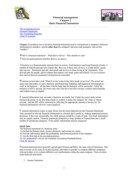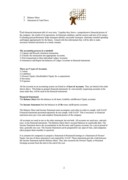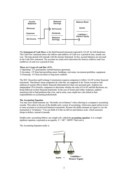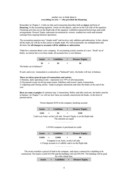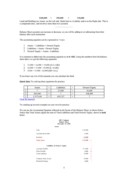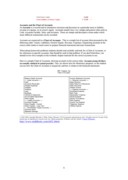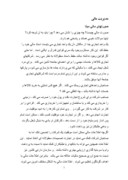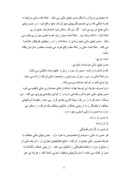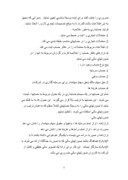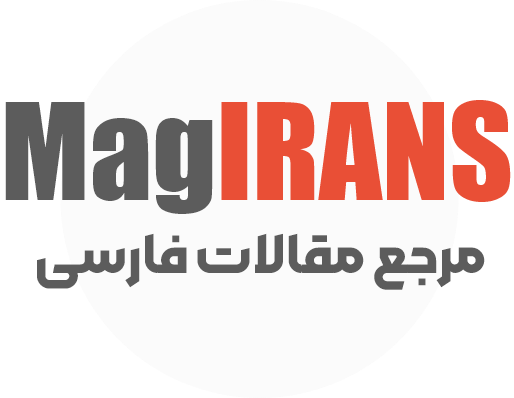بخشی از مقاله
Chapter 2
Basic Financial Statements
________________________________________
The accounting process
Financial Statements
The Accounting Equation
Chart of Accounts
________________________________________
Chapter 2 introduces you to the basic financial statements used to communicate a company's financial information to outsiders - parties other than the company's directors and managers, who are the "insiders."
What is a financial statement? What does it tell us? Why should we care?
T hese are good questions and they deserve an answer.
A business is a financial entity separate from its owners. Each business must keep financial records. A number of federal and state laws require this. But even if there were no laws, it would still be a good idea anyway. Businesses provide vital goods and services to those living in the community. They provide jobs for people, and tax dollars that improve our roads, parks and schools. It is in everyone's best interest that our community's businesses be successful.
B usiness owners take a risk. What if no one wants to buy their goods or services? The owner has spent time and money to start a business, purchased land, buildings and equipment, hired people to work in the business.... all this done with the hope that the business will be successful. And if the business is NOT a success, the owner may have lost his or her life's savings, workers must find jobs, and creditors may go unpaid.
F inancial information may not make a business successful, but it helps the owner make sound business decisions. It can also help a bank or creditor evaluate the company for a loan or charge account. And the IRS will be interested in collecting the appropriate amount of income tax. So financial information will serve many purposes.
F inancial information comes in many forms, but the most important are the Financial Statements. They summarize relevant financial information in a format that is useful in making important business decisions. If this were not possible, the whole process would be a waste of time. Too much information may be equally useless. Financial statements summarize a large number of Transactions into a small number of significant categories. To be useful, information must be organized.
Quick Quiz
The financial statements of a business entity:
A) Include the balance sheet, income statement, and income tax return.
B) Provide information about the profitability and financial position of the company.
C) Are the first step in the accounting process.
D) Are prepared for a fee by the Financial Accounting Standards Board.
Click for answers
Financial statements have generally agreed-upon formats and follow the same rules of disclosure. This puts everyone on the same level playing field, and makes it possible to compare different companies with each other, or to evaluate different year's performance within the same company. There are three main financial statements:
1. Income Statement
2. Balance Sheet
3. Statement of Cash Flows
Each financial statement tells it's own story. Together they form a comprehensive financial picture of the company, the results of its operations, its financial condition, and the sources and uses of its money. Evaluating past performance helps managers identify successful strategies, eliminate wasteful spending and budget appropriately for the future. Armed with this information they will be able to make necessary business decisions in a timely manner.
The accounting process in a nutshell:
1) Capture and Record a business transaction,
2) Classify the transaction into appropriate Accounts,
3) Post transactions to their individual Ledger Accounts,
4) Summarize and Report the balances of Ledger Accounts in financial statements.
There are 5 types of Accounts.
1) Assets
2) Liabilities
3) Owners' Equity (Stockholders' Equity for a corporation)
4) Revenues
5) Expenses
All the accounts in an accounting system are listed in a Chart of Accounts. They are listed in the order shown above. This helps us prepare financial statements, by conveniently organizing accounts in the same order they will be used in the financial statements.
Financial Statements
The Balance Sheet lists the balances in all Asset, Liability and Owners' Equity accounts.
The Income Statement lists the balances in all Revenue and Expense accounts.
The Balance Sheet and Income Statement must accompany each other in order to comply with GAAP. Financial statements presented separately do not comply with GAAP. This is necessary so financial statement users get a true and complete financial picture of the company.
All accounts are used in one or the other statement, but not both. All accounts are used once, and only once, in the financial statements. The Balance Sheet shows account balances at a particular date. The Income Statement shows the accumulation in the Revenue and Expense accounts, for a given period of time, generally one year. The Income Statement can be prepared for any span of time, and companies often prepare them monthly or quarterly.
It is common for companies to prepare a Statement of Retained Earnings or a Statement of Owners' Equity, but one of these statement is not required by GAAP.
These statements provide a link between the Income Statement and the Balance Sheet. They also reconcile the Owners' Equity or Retained Earnings account from the start to the end of the year.
The Statement of Cash Flows is the third financial statement required by GAAP, for full
disclosure. The Cash Flow statement shows the inflows and outflows of Cash over a period of time, usually one year. The time period will coincide with the Income Statement. In fact, account balances are not used in the Cash Flow statement. The accounts are analyzed to determine the Sources (inflows) and Uses (outflows) of cash over a period of time.
There are 3 types of cash flow (CF):
1) Operating - CF generated by normal business operations
2) Investing - CF from buying/selling assets: buildings, real estate, investment portfolios, equipment.
3) Financing - CF from investors or long-term creditors
The SEC (Securities and Exchange Commission) requires companies to follow GAAP in their financial statements. That doesn't mean companies do what they are supposed to do. Enron executives had millions of reasons ($$) to falsify financial information for their own personal gain. Auditors are independent CPAs hired by companies to determine whether the rules of GAAP and full disclosure are being followed in their financial statements. In the case of Enron and Arthur Andersen, auditors sometimes fail to find problems that exist, and in some cases might have also failed in their responsibilities as accounting professionals.
The Accounting Equation
You may have heard someone say "the books are in balance" when referring to a company's accounting records. This refers to the use of the double-entry system of accounting, which uses equal entries in two or more accounts to record each business transaction. Because the dollar amounts are equal we say the transaction is "in balance." You can think of it like an old two pan balance scale, which measures things in dollars, instead of pounds.
Doub
le-entry accounting follows one simple rule, called the accounting equation. It is a simple algebraic equation, expressed as an equality. E = MC2 OOPS! That's not it.
The Accounting Equation really is:
Assets = Liabilities +
Owners' Equity
another way to think about it
everything we own = who provided the financing
Remember in Chapter 1, I told you that each transaction describes both an object and form of financing. In the accounting equation, Assets are the objects, and are on the Left side of the equation. Financing activities are on the Right side of the equation. Liabilities represent borrowings and credit arrangements. Owners' Equity represents investments by owners, residual net worth and retained earnings from ongoing business operations.
The accounting equation uses "simple math" and involves only addition and subtraction. In fact, almost all the math you will do in this course is simple math. We will occasionally use multiplication and division, but all changes to accounts will be addition or subtraction.
Think fo
r a moment about a new company. It's accounting system consists of a new, "fresh" set of books, no entries have ever been made, all accounts have a zero balance.
Assets = Liabilities + Owners' Equity
$0 = $0 + $0
The books are in balance!!
If each, and every, transaction is a entered as a "balanced" entry, the books will stay in balance.
There are three general types of transactions and entries.
1) Routine, daily operating events - represents over 99% of all transactions.
2) Occasional events involving major assets, liabilities and owners' equity transactions.
3) Adjusting and Closing entries - made to prepare statements and close the books at the end of the year.
Here are some examples of common type 2 transactions. Before and after each one, the books must be in balance. In Chapter 3 we will see how these are actually entered into the books, in the form of journal entries.
Owner deposits $100 in the company checking account.
Assets = Liabilities + Owners' Equity
$100 = $0 + $100
Cash is an Asset, on the Left side. Owners' Equity is on the Right side.
The amounts are equal
________________________________________
A $1000 computer is purchased on credit.
Assets = Liabilities + Owners' Equity
$1000 = $1000 + $0
Computer is an Asset, on the Left side.
A Charge account is a Liability and is on the Right side.
________________________________________rs a parcel of land to the company, and signs a contract for a building to be constructed. The land is worth $10,000 and the building will cost $90,000. The building will be paid for with a bank loan.
Assets = Liabilities + Owners' Equity
$100,000 = $90,000 + $10,000
Land and Building are Assets, on the Left side. Bank loan is a Liability and is on the Right side. This is a compound entry, and involves more than two accounts.
________________________________________
Balance Sheet accounts can increase or decrease, so you will be adding to or subtracting from their balance after each transaction.
The accounting equation can be expressed in 3 ways:
1. Assets = Liabilities + Owners' Equity
2. Liabilities = Assets - Owners' Equity
3. Owners' Equity = Assets - Liabilities
It is common to abbreviate the accounting equation as A=L+OE. Using the numbers from the balance sheet above we get the following equations:
1. 33,000 = 14,000 + 19,000 [A=L+OE]
2. 14,000 = 33,000 - 19,000 [L=A-OE]
3. 19,00 = 33,000 - 14,000 [OE=A-L]
If you know any two of the amounts you can calculate the third.
Quick Quiz Try solving these equations for practice.
Assets = Liabilities + Owners' Equity
1 ? = 27,000 + 36,000
2 426,600 = ? + 168,400
3 1,537,618 = 692,327 + ?
Click for answers
Try making up several examples on your own for practice.
We can see the Accounting Equation reflected in the layout of the Balance Sheet, as shown below. Notice that Total Assets equals the sum of Total Liabilities and Total Owners' Equity, shown in bold below.
ABC Company
Balance Sheet
December 31, 2002
Assets
Cash $ 10,000
Accounts Receivable 6,000
Inventory 17,000
Total Assets $ 33,000 <-
|
Liabilities & Owners' Equity |
Accounts Payable $ 6,000 E
Notes Payable 8,000 Q
Total Liabilities 14,000 U
A
Common Stock, $1 par 10,000 L
Retained Earnings 9,000 |
Total Owners' Equity 19,000 |
Total Liabilities & Owners' Equity $ 33,000 <-
Accounts and the Chart of Accounts
An Account is a record used to summarize increases and decreases in a particular asset or liability, revenue or expense, or in owner's equity. Accounts usually have very simple and generic titles such as Cash, Accounts Payable, Sales, and Inventory. These are simple and descriptive terms under which many different transactions can be recorded.
Accounts are organized in a Chart of Accounts . This is a simple list of account titles presented in the following order: Assets, Liabilities, Owners' Equity, Revenue,
Expenses. Organizing accounts in the correct order makes it much easier to prepare financial statements and enter transactions.
When doing homework problems students should read carefully and look for a Chart of Accounts, or for references to specific accounts, that should be used in that problem. If you don't find these, you should review the examples in the textbook chapter material for the correct accounts to use.
Here is a sample Chart of Accounts, showing accounts in the correct order. Account group dividers are usually omitted in actual practice. They are shown here for illustrative purposes, so the student can see how the Chart of Accounts is organized, and how it relates to the financial statements.
ABC Company, Inc.
Chart of Accounts
Balance Sheet Accounts
---- Asset Accounts ----
Cash
Accounts Receivable
Prepaid Expenses
Supplies
Inventory
Land
Buildings
Vehicles & Equipment
Accumulated Depreciation
Other Assets
---- Liability Accounts ----
Accounts Payable
Notes Payable - Current
Notes Payable - Long Term
---- Stockholders' Equity Accounts ----
Common Stock
Retained Earnings Income Statement Accounts
---- Revenue Accounts ----
Sales Revenue
Sales Returns & Allowances
Sales Discounts
Interest Income
---- Expense Accounts ----
Advertising Expense
Bank Fees
Depreciation Expense
Payroll Expense
Payroll Tax Expense
Rent Expense
Income Tax Expense
Telephone Expense
________________________________________
© 2002-2005 Copyright Malcolm E. White, Fulton, Missouri, USA For personal educational use only. All rights reserved. No part of this tutorial may be reproduced or stored in any way without permission. Problems with this website? Contact Webmaster.
http://www.middlecity.com/ch02.shtml
مدیریت مالی
صورتهاي مالي مبنا
صورت مالي چيست؟ چه چيزي را نشان مي دهد ؟ چرا بايد به آن توجه كرد؟
اينها سوالات خوبي هستند و پاسخي هم دارند.
يك واحد تجاري جدا از مالكان آن، يك واحد تجاري مي بايست اسناد مالي خود را حفظ كند .اين كار مستلزم وجود يك سري قوانين فدرال و ايالتي است . اما حتي اگر قوانين وجود نداشته باشد، حفظ اسناد، معقولانه به نظر مي رسد . شركتهاي تجاري كالاها و خدمات مهمي را براي اعضاي جامعه تأمين مي كنند . براي مرد شغل ايجاد مي كنند ، با مالياتي كه مي پردازند جاده ها بازسازي مي شود و پاركها و مدارس ساخته مي شوند و اين آرزوي تمام مردم است كه شركتهاي تجاري جامعة آنها موفق باشند .
صاحبان واحدهاي تجاري ريسك مي كنند . اگر هيچ كس تمايلي به خريد كالاها و خدمات آنها نداشته باشد ، چه اتفاقي مي افتد ؟
صاحب شركت براي شروع تجارت دقت و پول خود را صرف مي كند ، زميني را خريداري مي كند و يا ساختمان و تجهيزات را خريداري مي كند . افرادي را بر كار در شركت به كار مي گيرد و … وي تمام اين كارها را به اميد موفقيت در تجارت انجام مي دهد . و اگر در تجارت خود موفقيت كسب نكند ، ممكن است تمام پس انداز (سرمايه) خود را از دست دهد ، كاركنان او بادي به دنبال شغل بگردند و بدهي طلبكاران نيز پرداخت نشود .
اگرچه اطلاعات مالي ممكن است موفقيت يك شركت را تضمين نكند اما به صاحبان شركت كمك مي نمايد در تجارت تصميمات معقولانه اي اتخاذ نمايند . اين اطلاعات همچنين مي تواند به بانكها و يا طلبكاران كمك نمايد تا نسبت به پرداخت وام يا سرمايه گذاري ارزيابي بهتري داشته باشند . و سازمان دارايي كشور نيز نسبت به جمع آوري صحيح ماليات علاقه مند مي باشد . بنابراين شوند
اما مهمترين نوع آن به شكل صورتهاي مالي مي باشد . اطلاعات مالي مرتبط به هم به شكلي كه براي تصميم گيريهاي مهم شركت مفيد واقع شود ، در صورتهاي مالي جمع آوري مي شود . اگر اين كار ممكن نبود تمام فرآيند جمع آوري اطلاعات ، اتلاف وقت بود . اطلاعات بسيار زياد هم به همين ميزان بي فايده مي باشد . صورتهاي مالي حجم زيادي از معاملات را در رديفهاي كوچكتر خلاصه مي كنند . اطلاعات مالي بر آنكه مفيد واقع شوند مي بايست منظم و سازمان يافته باشند .
تست سريع :
صورتهاي مالي مؤسسات تجاري :
ب) اطلاعاتي در مورد ميزان سوددهي و وضعيت مالي شركت ارائه مي نمايد .
ج) اولين قدم در فرآيند حسابداري مي باشد .
د) با صرف هزينه اي توسط هيئت استانداردهاي حسابداري مالي تنظيم مي شود .
صورتهاي مالي عموماً فرم يكساني دارند و از قوانين يكساني پيروي مي كنند . اين مسأله ، تمام افراد را در يك زمينة كاري يكسان قرار مي دهد و مقايسة شركتهاي مختلف با يكديگر و يا ارزيابي عملكرد مالهاي مختلف يك شركت را ممكن مي سازد سه صورت مالي اصلي وجود دارد :
1ـ صورت درآمد
2ـ ترازنامه
3ـ صورت گردش نقدينگي
هر صورت مالي ، موضوع مخصوص به خود دارد . صورتهاي مالي مختلف با هم يك تصوير مالي جامع از شركت ، نتايج فعاليتهاي تجاري آن ، شرايط مالي آن و منابع و موارد استفادة نقدينگي را تشكيل مي دهند . ارزيابي عملكرد گذشته به مديران كمك مي نمايد تا استراتژيهاي موفقيت آميزي اتخاذ كنند ، هزينه اي غير ضروري را حذف كنند براي آينده بودجة مناسبي تعيين نمايند . مديراني كه مجهز به اين اطلاعات باشند قادرند تا به موقع تصميمات تجاري لازم را اتخاذ نمايند .
فرآيند حسابداري به طور خلاصه :
1ـ معاملات تجاري را ثبت و ضبط مي نمايد .
2ـ معاملات تجاري را در حسابهاي مناسب طبقه بندي مي كند .
3ـ اطلاعات مربوط به معاملات را در دفاتر حساب ثبت مي كند .
4ـ ترازهاي دفاتر حساب را خلاصه كرده و گزارش مربوط به آنها را در صورتهاي مالي ثبت م
پنج نوع حساب وجود دارد :
1ـ حساب سرمايه
2ـ حساب بدهي
3ـ حق سهام مالك (حق سهام سهامدار براي سرمايه گذاري در شركت)
4ـ حساب هزينه ها
تمام اين حسابها در يك سيستم حسابداري در يك جدول مربوط به حسابها ، ليست مي شوند . اين حسابها به ترتيب بالا قرار مي گيرند . اين جدول ها به ما كمك مي نمايد تا صورتهاي مالي را به وسيلة حسابهاي كاملاً منظم كه به همان ترتيب در صورتهاي مالي استفاده مي شوند ، تنظيم نماييم .
صورتهاي مالي :
ترازنامه ، تراز تمام سرمايه ها ، بدهيها و حقوق سهام سهامدار را نشان مي دهد.
صورت درآمد ، تراز تمام درآمدها و هزينه ها را نشان مي دهد .
ترازنامه و صورت درآمد مي بايست با يكديگر هم خواني داشته باشند تا با GAAP هماهنگ باشند صورتهاي مالي كه به صورت جداگانه ارائه مي شوند با GAAP سازگار نيستند . اين كار براي ارائه يك تصوير مالي حقيقي و كامل از شركت به كاربران صورتهاي مالي ضروري مي باشد .
تمامي حسابها در ترازنامه ها يا صورتهاي درآمد ، و نه در هر دو آنها ، استفاده مي شوند . تمامي حسابها تنها و تنها يك بار در صورتهاي مالي ثبت مي شوند . ترازنامه ، تراز حسابها در يك تاريخ مشخص را نشان مي دهد . صورتهاي مالي مجموع حسابهاي درآمد و هزينه را در طي يك دورة معين كه معمولاً يك سال مي باشد ، نشان مي دهد . صورت درآمد را مي توان در براي هر دورة زماني تنظيم كرد و شركتها اغلب اين صورتها را به صورت ماهانه يا سه ماهه تهيه مي كنند .
در سازمانها اينطور معمول است كه صورتي از سود انباشته و يا حقوق سهام سهامدار تهيه مي
كنند اما يكي از اين صورتها مورد نياز GAAP نمي باشد . اين صورتها ، يك نوع ارتباط ميان صورت درآمد و ترازنامه ايجاد مي كند . اين صورتها همچنين سبب هماهنگي ميان حقوق سهام سهامدار و سود انباشته از آغاز تا پايان مي شود .
صورت گردش نقدينگي , سومين صورت مالي مي باشد كه از طرف GAAP براي بررسي كامل
خواسته مي شود . صورت گردش نقدينگي ميزان ورود و خروج نقدينگي را طي يك دوة زماني كه معمولاً يكسال مي باشد نشان مي دهد .
دورة زماني صورت گردش نقدينگي با دورة صورت درآمد منطبق مي باشد . در حقيقت ، ترازهاي حساب در صورت گردش نقدينگي استفاده نمي شوند . اين حسابها مورد تحليل قرار مي گيرند تا منبع (ورود نقدينگي) و استفاده (خروج نقدينگي) نقدينگي را در طول يك دوره تعيين نمايند .
سه نوع گردش نقدينگي وجود دارد :
1ـ جريانهاي نقدينگي عملياتي كه با فعاليتهاي عادي شركت ايجاد مي شوند .
2ـ جريانهاي نقدينگي سرمايه گذاري كه از طريق خريد / فروش سرمايه : ساختمان ، املاك غيرمنقول ، اوراق بهادار و تجهيزات ايجاد مي شوند .
3ـ جريانهاي نقدينگي تأمين مالي كه از محل سرمايه گذاران و يا سرمايه گذاريهاي بلندمدت ايجاد مي شوند .
كميسيون بورس و اوراق بهادار (SEC) از شركتها مي خواهد تا مطابق مقررات GAAP در تنظيم صورتهاي مالي خود عمل نمايند و اين بدان معناست كه شركتها اجازه ندادند هر چرا كه خواستند انجام دهند . مديران اجرايي شركت انرون به دلايل شخصي دست به جعل اطلاعات مالي بردند چرا كه از اين طريق ميليونها دلار به جيب بردند . حسابرسان شركتهاي مستقلي هستند كه توسط واحدهاي تجاري به كار گرفته مي شوند تا مشخص سازند كه آيا تمامي مقررات GAAP و حسابهاي مالي به درستي در صورتهاي مالي رعايت شده است يا خير .
در مورد انرون و آرتورافدرسون ، حسابرسان نتوانستند مشكلي در صورتهاي مالي پيدا كنند و در برخي موارد ممكن است در انجام مسئوليت هاي خود به عنوان مسئول حسابداري ، كوتاهي نمايند .
معادله حسابداري :
شايد شنيده باشيد كه يك نفر در هنگام اشاره اسناد به حسابهاي شركت بگويد كه «حسابها تراز است .» اين اصطلاح به استفاده از يك سيستم دو جانبه در حسابداري اشاره دارد كه از دو ورودي برابر در دو يا چند حساب استفاده مي كند تا هر معاملة شركت را ثبت نمايد . از آنجايي كه مقادير دو حساب با هم برابر مي باشد ، ممكن است بگوييم كه معامله «تراز» مي باشد . مي توان اين شيوه را به دو كفة ترازو تشبيه كرد ، كه به جاي پاوند ، (وزن) ارزش اجناس را با دلار (وزن) ارزش اجناس را با دلار (قيمت آن) اندازه گيري مي نمايد .
حسابداري دو جانبه از يك قانون ساده پيروي مي كند كه معادله حسابداري ناميده مي شو
د . معادلة حسابداري ، يك معادلة جبري ساده است كه به صورت تساوي E = MC2 oops بيان مي شود ! البته در واقع اينطور نيست . معادلة حسابداري واقعي به صورت زير است :
حقوق سهام مالكان + تعهدات (بدهيها) = سرمايه
راه ديگري كه مي توان به آن نگاه كرد به صورت زير مي باشد :
چه كسي اين سرمايه ها را تأمين مالي مي كند = هر آنچه كه ما داريم
به خاطر داشته باشيد گفتيم كه هر معامله ، هم يك شی دو هم نحوه تأمين مالي آن را نشان مي دهد . در معادلة حسابداري ، سرمايه ها همان اشياء مي باشند كه در طرف چپ معادله قرار مي گيرند . بدهيها (تعهدات) نمايانگر قرض و طلب ميباشند .حقوق سهام سهامدر نشان دهندة ، سرمايه گزاريهاي سهامداران ارزش خالص مازاد و درآمد انباشته حاصل از فعاليتهاي تجاري آتي مي باشد .
در معادلة حسابداري از اعداد رياضي استفاده مي شود و تنها مستلزم جمع و منها مي باشد . در حقيقت ، تقريباً تمام عملياتي كه شما در اين رشته استفاده مي كنيد همين رياضيات معمولي مي بشاد . گاهي اوقات از ضرب و تقسيم هم استفاده مي شود اما تمام تضمرات مربوط به حسابها ، از طريق جمع و تفريق محاسبه مي شود .
براي يك لحظه به يك شركت جديد فكر كنيد . تقسيم حسابداري آن از يك مجموعه دفاتر جديد ، خالي تشكيل شده كه هيچ نوع اطلاعاتي وارد آن شده است و تراز تمام حشابها صفر مي باشد .
حقوق سهام سهامداران + تعهدات = سرمايه ها
0 دلار + 0 دلار = 0 دلار
دفاتر تراز مي باشند .
اگر هر معامله اي كه انجام مي شود به صورت يك آرتيكل تراز در دفاتر ثبت شود ، دفاتر نيز به صورت تراز باقي مي مانند . عموماً سه نوع معامله و آرتيكل وجود دارد :
1ـ اتفاقات عملياتي عادي و روزانه ، بالغ بر 99 درصد تعاملات را تشكيل مي دهد .
2ـ رويدادهاي موضعي كه شامل معاملات مهم سرمياه ها ، تعهدات و حقوق سهام سهامداران مي باشد .
3ـ تطبيق و تبين حسابها ، كه براي تهية صورتها و تبين دفاتر در پايان سال به كار مي رود .
در اينجا چند مثال معمول از دو نوع معامله ، آمده است . قبل و بعد از هر معامله ، دفاتر مي بايست در تراز باشند .
در فصل 3 : ما خواهيم ديد كه اين اطلاعات عيناً چگونه همانند اطلاعات خبري وارد دفاتر م
ي شوند .
سرمايه گذار مبلغ 100 دلار در شركت سپرده گذاري مي كند .
حقوق سهام سهامدار + تعهدات = سرمايه
100 دلار + 0 = 100 دلار
پول نقدر يك نوع سرمايه مي باشد كه در طرف چپ معادله قرار دارد . سهم سهامدار نيز در سمت راست قرار دارد . مقدار آنها برابر مي باشد .
يك كامپيوتر به قيمت 000/1 دلار به صورت قطعي خريداري شده است .
0 دلار + 000/1 دلار = 000/1 دلار
كامپيوتر يك نوع سرمايه مي باشد كه در سمت چپ قرار دارد . حساب هزينه (پرداخت) يك تعهد است كه در سمت راست قرار مي گيرد . مالك يك قطعه زمين را به شركت مي دهد و قراردادي براي ساخت يك ساختمان با شركت متعقد مي نمايد . ارزش زمين 000/10 دلار مي باشد و ساختمان 000/90 دلار ارزش خواهد داشت . هزينة ساختمان توسط يك وام بانكي پرداخت مي شود .
سهم سهامدار + تعهدات = سرمايه
000/10 دلار + 000/90 دلار = 000/100 دلار
زمين و ساختمان سرمايه مي باشند و در سمت چپ قرار مي گيرند . وام بانكي هم يك تعهد است كه در سمت راست قرار مي گيرد . اين نوع معادله يك راديكال مركب است و بيش از 2 حساب را شامل مي شود .
معادلة حسابداري را مي توان به 3 روش بيان كرد .
1ـ حقوق سهامدارن + تعهدات = سرمايه
2ـ حقوق سهامدارن ـ سرمايه ها = تعهدات
3ـ تعهدات ـ سرمايه ها = حقوق سهامداران
اينطور معمول است كه معادله حسابداري را به صورت A = l + OE نشان مي دهند . با استفاده از ارقام موجود در ترازنامة بالا ، به معادلات زير مي دهيم .
1) 33/000 = 14/000 + 19/000 [A = L + OE]
2) 14/000 = 33/000 - 19/000 [L = A - OE]
3) 1/900 = 33/000 - 14/000 [OE = A - L]
اگر شما دو تا از اين مقادير را داشته باشيد مي تواند مقدار سوم را محاسبه كنيد .
تست سريع عملاً اين معادلات را حل مي كند .
حقوق سهامدار + تعهدات = سرمايه
1) 000/36 + 000/27 = ؟
2) 400/168 + ؟ = 000/426
3) ؟ + 327/692 = 618/537/1
سعي كنيد خودتان براي تمرين ، چند مثال متفاوت بزنيد .
مشاهده مي كنيم كه معادلة حسابداري در ساختار ترازنامه ، همانطور كه در زير نشان داده خواهد شد ، منعكس مي شود . توجه داشته باشيد كه ارزش سرماية نهايي با مجموع تعهدات نهايي و سهم سهامداران ، برابر مي باشد .
ترازنامه شركت ABC ، دسامبر 31 ، 2002
سرمايه ها
000/10 دلار نقدينگي
000/6 دلار حسابهاي قابل دريافت
000/ 17 دلار موجودي
000/330 دلار سرماية كل

